Page 440 of 632
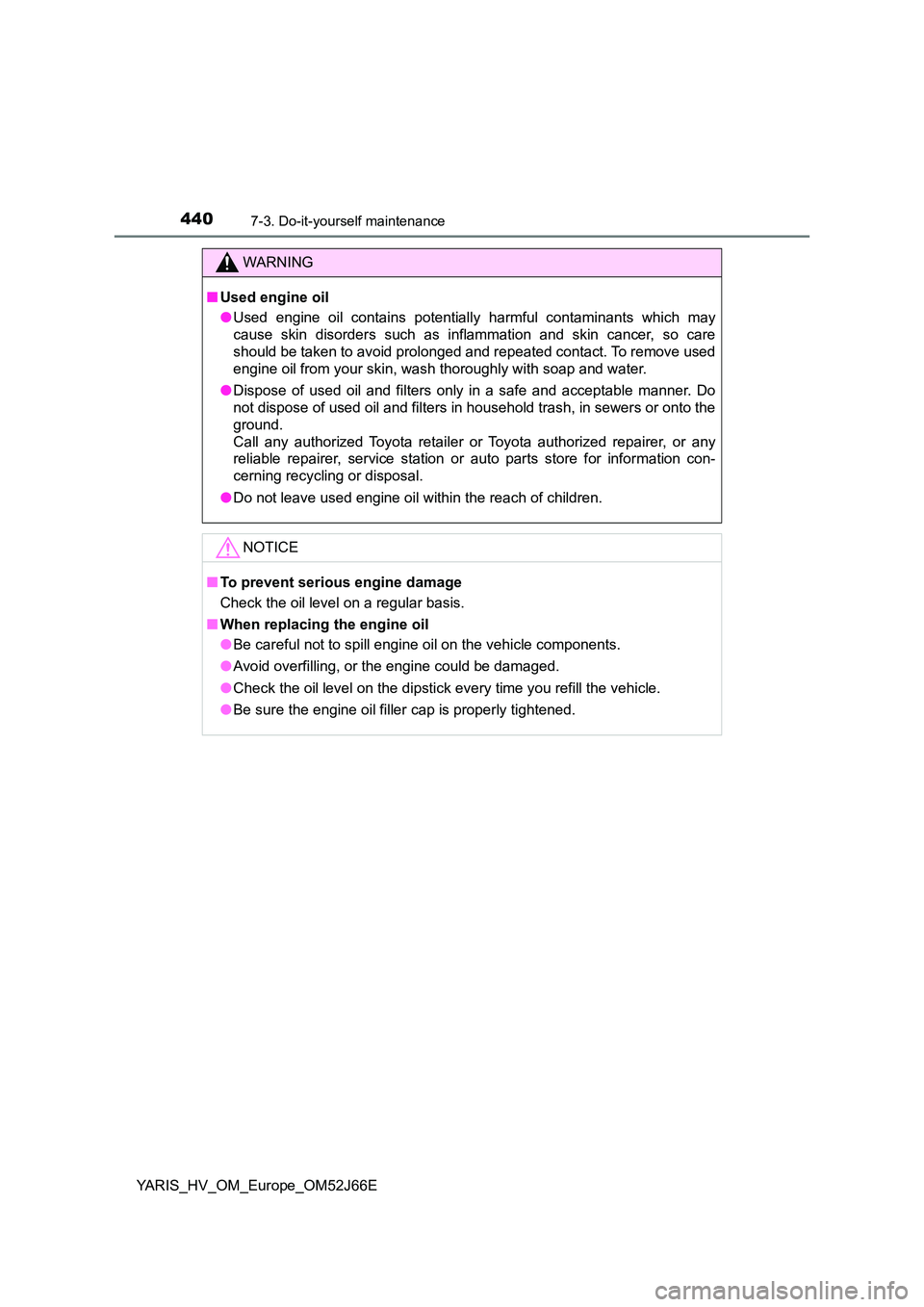
4407-3. Do-it-yourself maintenance
YARIS_HV_OM_Europe_OM52J66E
WARNING
■Used engine oil
● Used engine oil contains potentially harmful contaminants which may
cause skin disorders such as inflammation and skin cancer, so care
should be taken to avoid prolonged and repeated contact. To remove used
engine oil from your skin, wash thoroughly with soap and water.
● Dispose of used oil and filters only in a safe and acceptable manner. Do
not dispose of used oil and filters in household trash, in sewers or onto the
ground.
Call any authorized Toyota retailer or Toyota authorized repairer, or any
reliable repairer, service station or auto parts store for information con-
cerning recycling or disposal.
● Do not leave used engine oil within the reach of children.
NOTICE
■To prevent serious engine damage
Check the oil level on a regular basis.
■ When replacing the engine oil
● Be careful not to spill engine oil on the vehicle components.
● Avoid overfilling, or the engine could be damaged.
● Check the oil level on the dipstick every time you refill the vehicle.
● Be sure the engine oil filler cap is properly tightened.
Page 442 of 632
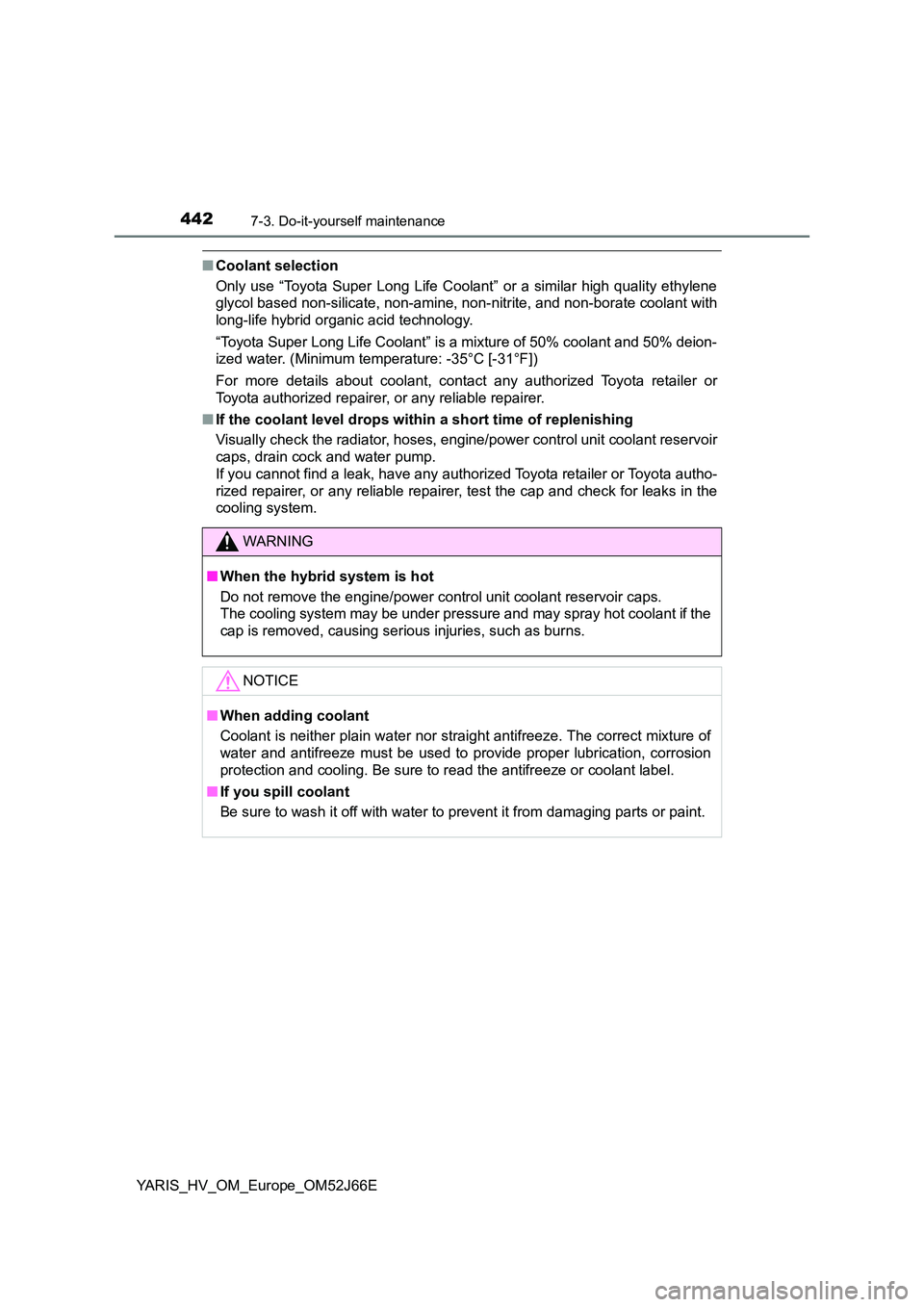
4427-3. Do-it-yourself maintenance
YARIS_HV_OM_Europe_OM52J66E
■Coolant selection
Only use “Toyota Super Long Life Coolant” or a similar high quality ethylene
glycol based non-silicate, non-amine, non- nitrite, and non-borate coolant with
long-life hybrid organic acid technology.
“Toyota Super Long Life Coolant” is a mixture of 50% coolant and 50% deion-
ized water. (Minimum temperature: -35°C [-31°F])
For more details about coolant, contact any authorized Toyota retailer or
Toyota authorized repairer, or any reliable repairer.
■ If the coolant level drops within a short time of replenishing
Visually check the radiator, hoses, engine/power control unit coolant reservoir
caps, drain cock and water pump.
If you cannot find a leak, have any authorized Toyota retailer or Toyota autho-
rized repairer, or any reliable repairer, test the cap and check for leaks in the
cooling system.
WARNING
■ When the hybrid system is hot
Do not remove the engine/power control unit coolant reservoir caps.
The cooling system may be under pressure and may spray hot coolant if the
cap is removed, causing serious injuries, such as burns.
NOTICE
■ When adding coolant
Coolant is neither plain water nor straight antifreeze. The correct mixture of
water and antifreeze must be used to provide proper lubrication, corrosion
protection and cooling. Be sure to read the antifreeze or coolant label.
■ If you spill coolant
Be sure to wash it off with water to prevent it from damaging parts or paint.
Page 443 of 632
4437-3. Do-it-yourself maintenance
7
Maintenance and care
YARIS_HV_OM_Europe_OM52J66E
Check the radiator and condenser and clear away any foreign objects.
If any of the above parts is extremely dirty or you are not sure of their
condition, have your vehicle inspected by any authorized Toyota
retailer or Toyota authorized repairer, or any reliable repairer.
If the washer fluid level is less
than “FULL” line, add washer fluid
to “FULL” line.
Radiator and condenser
WARNING
■ When the hybrid system is hot
Do not touch the radiator or condenser as they may be hot and cause seri-
ous injuries, such as burns.
Washer fluid
Ty pe B
Type A
WARNING
■ When adding washer fluid
Do not add washer fluid when the hybrid system is hot or operating as
washer fluid contains alcohol and may catch fire if spilled on the engine, etc.
Page 449 of 632
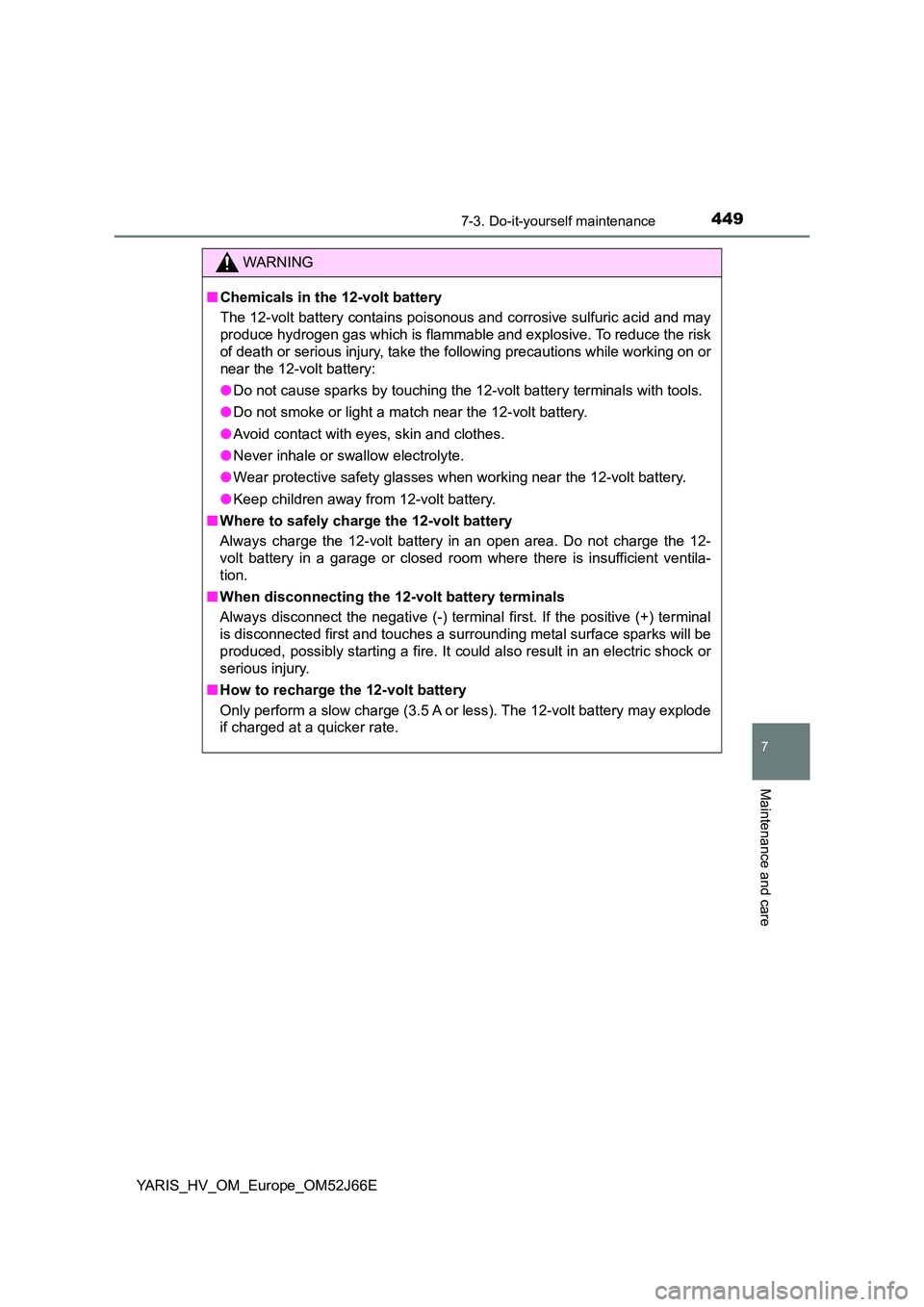
4497-3. Do-it-yourself maintenance
7
Maintenance and care
YARIS_HV_OM_Europe_OM52J66E
WARNING
■Chemicals in the 12-volt battery
The 12-volt battery contains poisonous and corrosive sulfuric acid and may
produce hydrogen gas which is flammable and explosive. To reduce the risk
of death or serious injury, take the following precautions while working on or
near the 12-volt battery:
● Do not cause sparks by touching the 12-volt battery terminals with tools.
● Do not smoke or light a match near the 12-volt battery.
● Avoid contact with eyes, skin and clothes.
● Never inhale or swallow electrolyte.
● Wear protective safety glasses when working near the 12-volt battery.
● Keep children away from 12-volt battery.
■ Where to safely charge the 12-volt battery
Always charge the 12-volt battery in an open area. Do not charge the 12-
volt battery in a garage or closed room where there is insufficient ventila-
tion.
■ When disconnecting the 12-volt battery terminals
Always disconnect the negative (-) terminal first. If the positive (+) terminal
is disconnected first and touches a surrounding metal surface sparks will be
produced, possibly starting a fire. It could also result in an electric shock or
serious injury.
■ How to recharge the 12-volt battery
Only perform a slow charge (3.5 A or less). The 12-volt battery may explode
if charged at a quicker rate.
Page 450 of 632
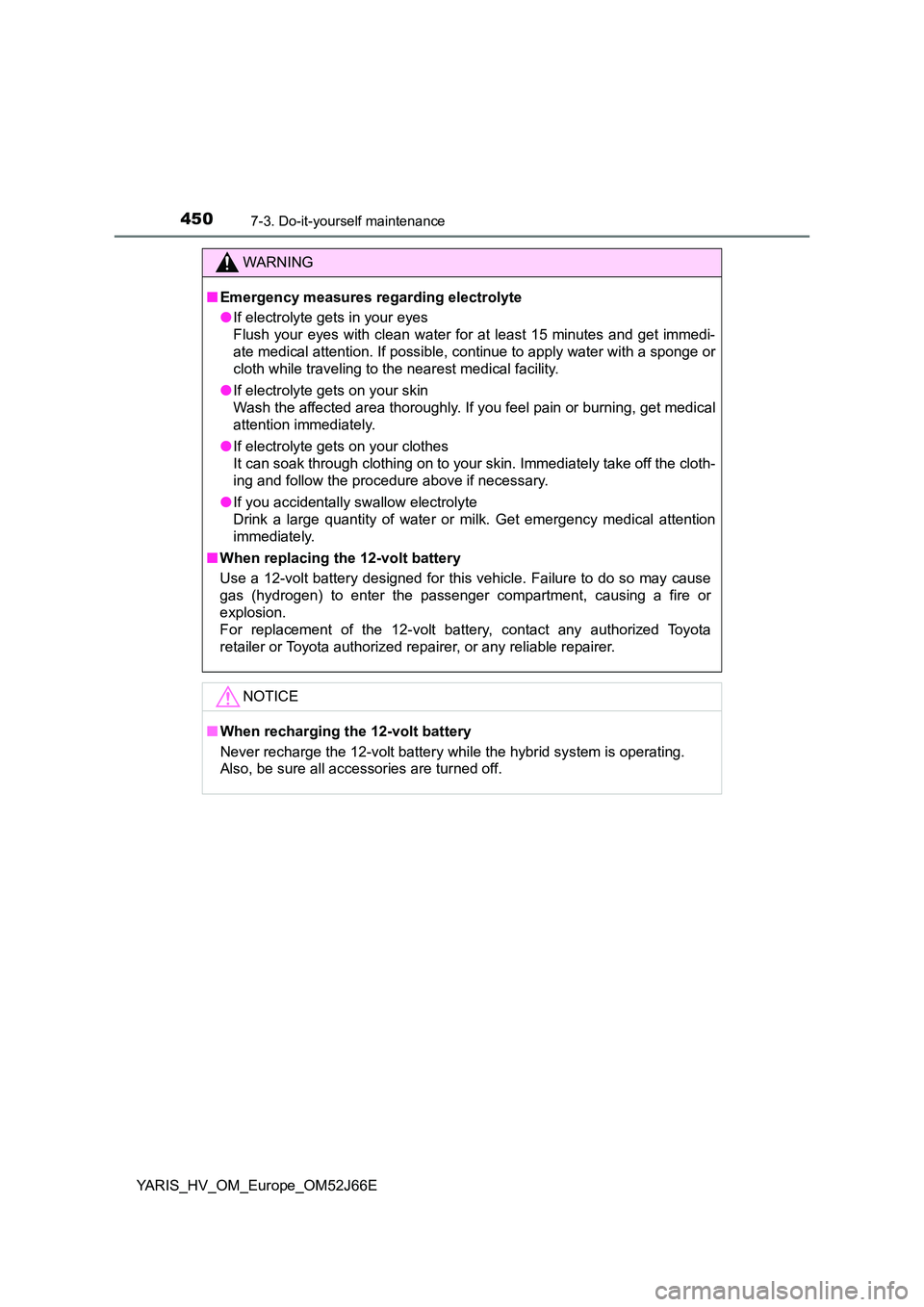
4507-3. Do-it-yourself maintenance
YARIS_HV_OM_Europe_OM52J66E
WARNING
■Emergency measures regarding electrolyte
● If electrolyte gets in your eyes
Flush your eyes with clean water for at least 15 minutes and get immedi-
ate medical attention. If possible, continue to apply water with a sponge or
cloth while traveling to the nearest medical facility.
● If electrolyte gets on your skin
Wash the affected area thoroughly. If you feel pain or burning, get medical
attention immediately.
● If electrolyte gets on your clothes
It can soak through clothing on to your skin. Immediately take off the cloth-
ing and follow the procedure above if necessary.
● If you accidentally swallow electrolyte
Drink a large quantity of water or milk. Get emergency medical attention
immediately.
■ When replacing the 12-volt battery
Use a 12-volt battery designed for this vehicle. Failure to do so may cause
gas (hydrogen) to enter the passenger compartment, causing a fire or
explosion.
For replacement of the 12-volt battery, contact any authorized Toyota
retailer or Toyota authorized repairer, or any reliable repairer.
NOTICE
■ When recharging the 12-volt battery
Never recharge the 12-volt battery while the hybrid system is operating.
Also, be sure all accessories are turned off.
Page 452 of 632
4527-3. Do-it-yourself maintenance
YARIS_HV_OM_Europe_OM52J66E
Rotate the tires in the order
shown.
To equalize tire wear and help
extend tire life, Toyota recom-
mends that tire rotation is carried
out approximately every 10000 km
(6000 miles).
When rotating front and rear tires
which have different tire inflation
pressures, do not fail to initialize
the tire pressure warning system
after tire rotation.
Rotate the tires in the order shown.
To equalize tire wear and help extend tire life, Toyota recommends
that tire rotation is carried out approximately every 10000 km
(6000 miles).
Tire rotation (vehicles with a tire pressure warning system)
Front
Tire rotation (vehicles without a tire pressure warning system)
Vehicles with a compact spare
tire or an emergency tire punc-
ture repair kit
Vehicles with a spare tire of
the same wheel type as the
installed tires
FrontFront
Page 453 of 632
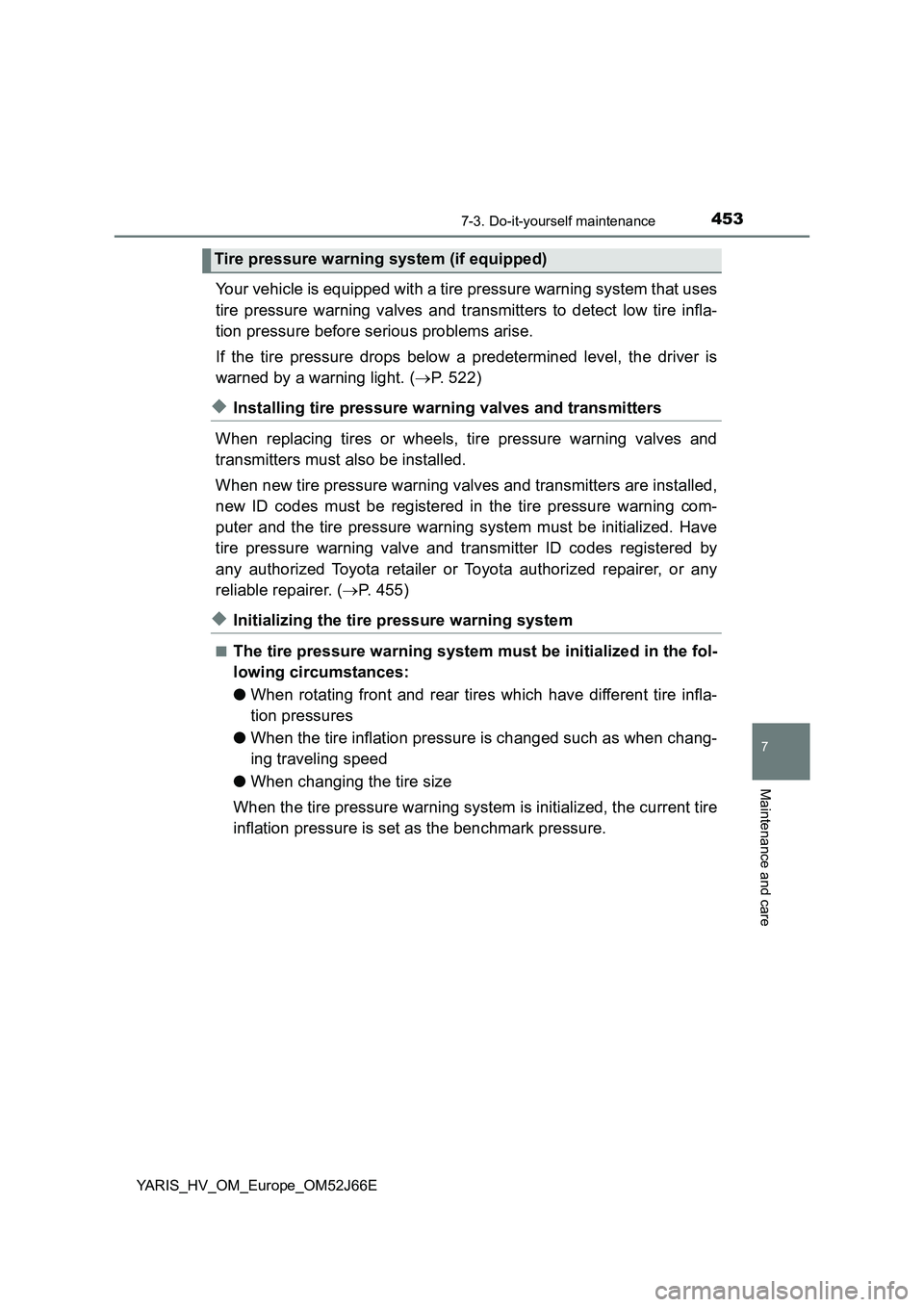
4537-3. Do-it-yourself maintenance
7
Maintenance and care
YARIS_HV_OM_Europe_OM52J66E
Your vehicle is equipped with a tire pressure warning system that uses
tire pressure warning valves and transmitters to detect low tire infla-
tion pressure before serious problems arise.
If the tire pressure drops below a predetermined level, the driver is
warned by a warning light. ( P. 522)
◆Installing tire pressure warning valves and transmitters
When replacing tires or wheels, tire pressure warning valves and
transmitters must also be installed.
When new tire pressure warning valves and transmitters are installed,
new ID codes must be registered in the tire pressure warning com-
puter and the tire pressure warning system must be initialized. Have
tire pressure warning valve and transmitter ID codes registered by
any authorized Toyota retailer or Toyota authorized repairer, or any
reliable repairer. ( P. 455)
◆Initializing the tire pressure warning system
■The tire pressure warning system must be initialized in the fol-
lowing circumstances:
● When rotating front and rear tires which have different tire infla-
tion pressures
● When the tire inflation pressure is changed such as when chang-
ing traveling speed
● When changing the tire size
When the tire pressure warning system is initialized, the current tire
inflation pressure is set as the benchmark pressure.
Tire pressure warning system (if equipped)
Page 454 of 632
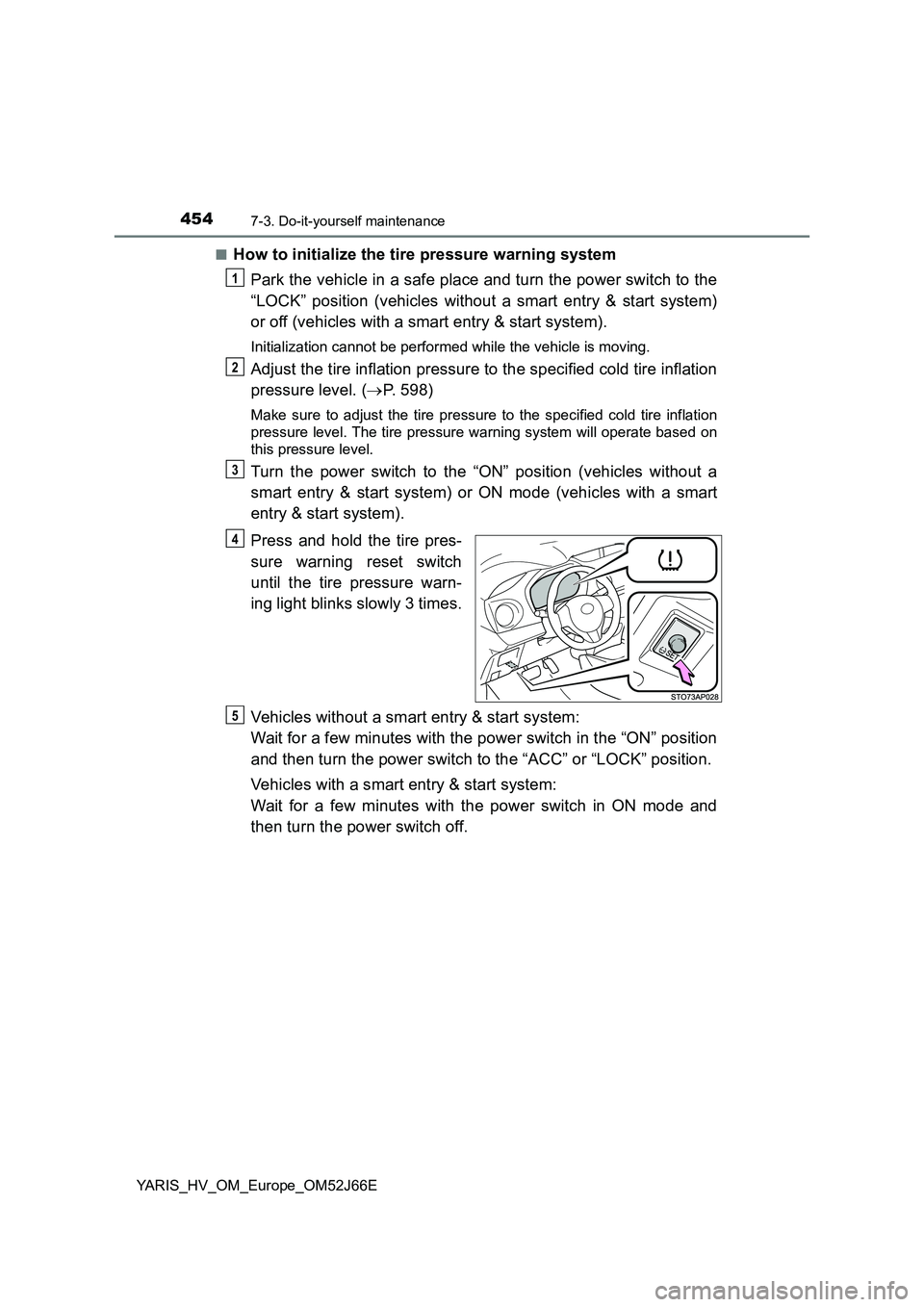
4547-3. Do-it-yourself maintenance
YARIS_HV_OM_Europe_OM52J66E
■How to initialize the tire pressure warning system
Park the vehicle in a safe place and turn the power switch to the
“LOCK” position (vehicles without a smart entry & start system)
or off (vehicles with a smart entry & start system).
Initialization cannot be performed while the vehicle is moving.
Adjust the tire inflation pressure to the specified cold tire inflation
pressure level. ( P. 598)
Make sure to adjust the tire pressure to the specified cold tire inflation
pressure level. The tire pressure warning system will operate based on
this pressure level.
Turn the power switch to the “ON” position (vehicles without a
smart entry & start system) or ON mode (vehicles with a smart
entry & start system).
Press and hold the tire pres-
sure warning reset switch
until the tire pressure warn-
ing light blinks slowly 3 times.
Vehicles without a smart entry & start system:
Wait for a few minutes with the power switch in the “ON” position
and then turn the power switch to the “ACC” or “LOCK” position.
Vehicles with a smart entry & start system:
Wait for a few minutes with the power switch in ON mode and
then turn the power switch off.
1
2
3
4
5